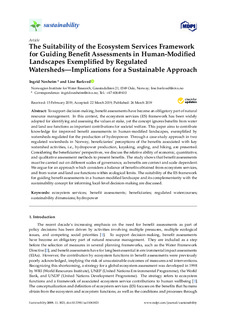The Suitability of the Ecosystem Services Framework for Guiding Benefit Assessments in Human-Modified Landscapes Exemplified by Regulated Watersheds—Implications for a Sustainable Approach
| dc.contributor.author | Nesheim, Ingrid | |
| dc.contributor.author | Barkved, Line | |
| dc.date.accessioned | 2019-10-08T07:00:15Z | |
| dc.date.available | 2019-10-08T07:00:15Z | |
| dc.date.created | 2019-03-29T08:08:32Z | |
| dc.date.issued | 2019 | |
| dc.identifier.citation | Sustainability. 2019, 11 (6), 1821. | nb_NO |
| dc.identifier.issn | 2071-1050 | |
| dc.identifier.uri | http://hdl.handle.net/11250/2620732 | |
| dc.description.abstract | To support decision-making, benefit assessments have become an obligatory part of natural resource management. In this context, the ecosystem services (ES) framework has been widely adopted for identifying and assessing the values at stake, yet the concept ignores benefits from water and land use functions as important contributions for societal welfare. This paper aims to contribute knowledge for improved benefit assessments in human-modified landscapes, exemplified by watersheds regulated for the production of hydropower. Through a case study approach in two regulated watersheds in Norway, beneficiaries’ perceptions of the benefits associated with key watershed activities, i.e., hydropower production, kayaking, angling, and hiking, are presented. Considering the beneficiaries’ perspectives, we discuss the relative ability of economic, quantitative, and qualitative assessment methods to present benefits. The study shows that benefit assessments must be carried out on different scales of governance, as benefits are context and scale dependent. We argue for an approach which considers a balance of benefits obtained from ecosystem services, and from water and land use functions within ecological limits. The suitability of the ES framework for guiding benefit assessments in a human-modified landscape and its complementarity with the sustainability concept for informing local-level decision-making are discussed. | nb_NO |
| dc.language.iso | eng | nb_NO |
| dc.publisher | MDPI | nb_NO |
| dc.rights | Navngivelse 4.0 Internasjonal | * |
| dc.rights.uri | http://creativecommons.org/licenses/by/4.0/deed.no | * |
| dc.title | The Suitability of the Ecosystem Services Framework for Guiding Benefit Assessments in Human-Modified Landscapes Exemplified by Regulated Watersheds—Implications for a Sustainable Approach | nb_NO |
| dc.type | Journal article | nb_NO |
| dc.type | Peer reviewed | nb_NO |
| dc.description.version | publishedVersion | nb_NO |
| dc.rights.holder | © 2019 by the authors | nb_NO |
| dc.source.pagenumber | 18 | nb_NO |
| dc.source.volume | 11 | nb_NO |
| dc.source.journal | Sustainability | nb_NO |
| dc.source.issue | 6 | nb_NO |
| dc.identifier.doi | 10.3390/SU11061821 | |
| dc.identifier.cristin | 1688721 | |
| dc.relation.project | Norges forskningsråd: 244050 | nb_NO |
| cristin.unitcode | 7464,30,22,0 | |
| cristin.unitname | Vann og samfunn | |
| cristin.ispublished | true | |
| cristin.fulltext | original | |
| cristin.qualitycode | 1 |
Tilhørende fil(er)
Denne innførselen finnes i følgende samling(er)
-
Publikasjoner fra Cristin - NIVA [2147]
-
Scientific publications [1172]

